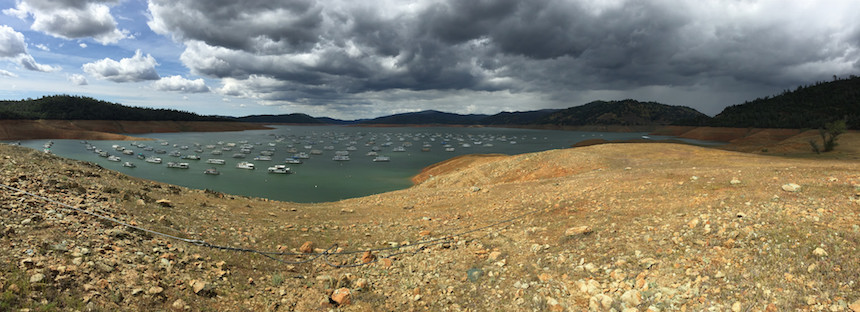
Lake Oroville State Recreation Area’s dramatically receding water line
Photo: Ray Bouknight via Flickr
In the face of the Southern California’s semi-arid Mediterranean climate, compounded by several years of drought throughout the state, the region has developed local resilience through state-of-the-art groundwater management.
The State has long faced water security challenges, marked by physical water scarcity, increasing economic expansion, and reliance on imported water. Traditionally water-strapped regions such as Orange County are faced with the difficult task of delivering safe and sustainable water to more than 3 million inhabitants. Situated on the coast of Southern California, Orange County includes many economically successful cities and draws the majority of its water resources from the large groundwater basin that underlies Northern and Central Orange County.
Now, Orange County authorities must venture beyond conventional water management solutions towards integrated and long-term water strategies to resolve their water insecurity.
Paving the way for a more resilient water system, authorities in northern and central Orange County have partnered to develop imaginative approaches to reducing dependence on imported water. The main goal is to protect the groundwater. To this end, the Orange County Water District (OCWD) was created as a collaborative effort to manage the aquifer on behalf of their client agencies, and now focuses on adapting local water systems to meet future projected needs. There are two key features of OCWD’s multifaceted strategy to efficiently use every drop: wastewater reuse and groundwater basin governance.
Wastewater reuse
Boasting the largest planned indirect potable reuse system in the world, OCWD’s Groundwater Replenishment System (GWRS) captures and reuses recycled water that has been treated to exceed federal and state drinking water standards. The System was implemented after carefully weighing the tradeoffs between collaboration and avoiding the costly construction of a second pipeline that disposes treated wastewater into the ocean several hundred feet below the water surface. The Orange Country Sanitation District (OCSD) served as a key partner in helping Orange County fund the System instead of building a second ocean disposal pipeline. To overcome the hurdle of the negative perception of reusing wastewater, a community education campaign was developed to help rethink the concept of recycled water. OCWD also enhances water resilience with an integrated approach that includes: monitoring and regulation of groundwater levels; investing in regional stormwater capture projects; preventing seawater intrusion by injecting water[1] along the coast to build a water barrier between freshwater and seawater, to protect water quality, and to maximize the ability to capture as much stormwater as possible during large storm events, to prevent storm water from flowing into the Santa Ana River; and offering financial incentives to encourage groundwater producers to reduce pumping.
Groundwater basin governance
The creative case of pursuing water sustainability in Orange County may serve as an example of an integrated water paradigm that presents tools and guidance to other urban centers, particularly including cities in developing countries. OCWD’s focus on groundwater basin governance through a diversified recharge strategy not only protects the quality of water in the aquifer from seawater intrusion, but also increases the storage capacity of the basin over time. The Orange County case is an example of , local source development projects, policy, and enhanced stakeholder coordination driven by two critical factors:
- Collaboration among regional stakeholders through a unifying authority devoted to groundwater basin management, as well as cooperation between regional water and sanitation districts, to yield fruitful water management results.
- Diversification and development of local water resources to reduce demands on water import, improve the water portfolio, and decrease the financial and energetic cost of water delivery.
The World Bank’s Water Scarce Cities (WSC) Initiative is designed to build on successful case studies of water resilient urban spaces to move technical and institutional solutions forward to client countries. Recognizing the common global challenge of increasing urban water stress, this initiative generates knowledge on urban water management approaches to facilitate knowledge cooperation between diverse global voices and provide technical assistance through World Bank engagement with water scarce cities.
with developing countries through the Water Scarce Cities Initiative. WSC is enabling North-South knowledge exchange and innovation to maintain the momentum toward a water secure world. WSC is documenting cases, such as that of Orange County, and sharing the successes and challenges of with cities in water scarce regions in the global South.
The WSC initiative invites cities and interdisciplinary teams to join together to push the boundaries of urban water innovation to create a more secure and resilient global water future.
